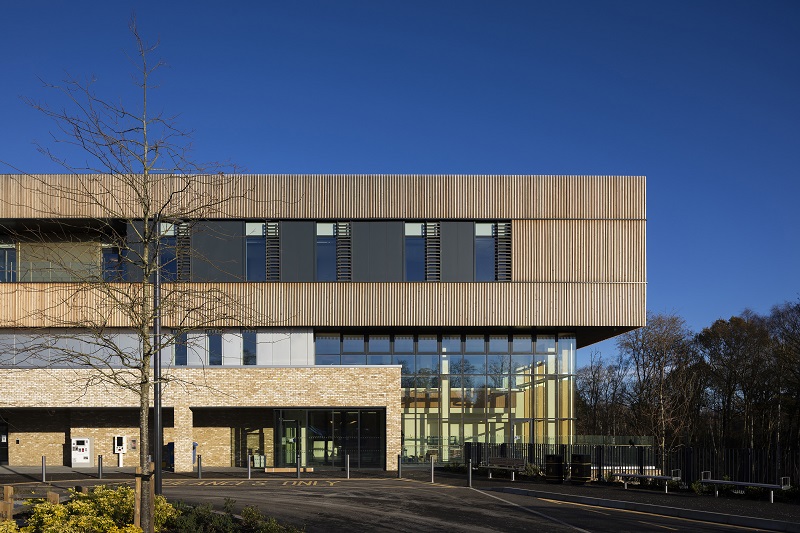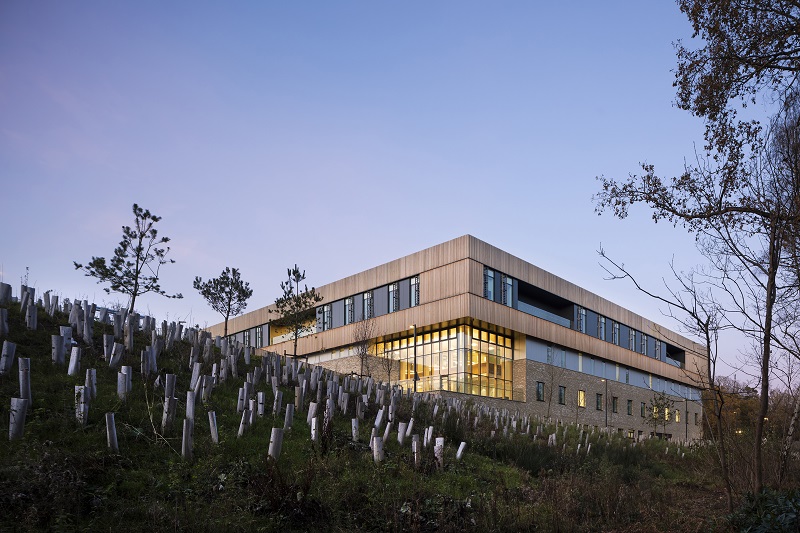Exactly 100 years after the facility first opened, Heatherwood Hospital in Ascot has undergone a transformation, taking inspiration from the original thinking that nature, landscaping, and fresh air have a positive impact on patient recovery.
The £98m new Heatherwood Hospital is a dedicated planned care facility for non-emergency care in Berkshire and beyond.
It welcomed its first patients earlier this year and will play a critical role in enabling Frimley Health NHS Foundation Trust to double patient numbers over the next decade, as well as addressing the ongoing COVID-19 elective care backlog.
Designed by BDP, the hospital is sited in a mature woodland, which has been enhanced to provide treetop views from internal spaces and woodland walks.
Location, location, location
Sean Woodhead, architect associate at BDP, told BBH: “When BDP first bid for the project in 2015 and discovered that the trust was looking at using the existing woodland site with this lovely kitchen garden from the original hospital we jumped at the opportunity to be involved as it is not often you get the chance to design a hospital in a location like this.”
From the outset, the design for the 11,500sq m hospital was to provide a clinically-efficient plan and maximise every opportunity to make the most of the therapeutic landscape.
Woodhead said: “The site was very overgrown, with rhododendron and cherry laurel, and was totally inaccessible.
“We managed to preserve three quarters of the woodland, cleared out all the under-scrub, and enhanced the site, while keeping it as natural as we could.”
The main arrival area is enclosed by woodland which helps to screen the adjacent car park.
And semi-mature trees form an avenue along the approach road, providing a structure and threshold to the hospital, complemented by an underplanting of ornamental shrubs.
A sense of calm
This naturalistic planting scheme blends into a more-formal, sensory planting scheme towards the building complex itself, leading the visitor on a journey through nature into the hospital and encouraging a sense of calm.
Defined by high-quality natural stone paving, the main entrance area extends to include the taxi/bus set-down/pick-up zone and creates a legible route linking the shared cycleway to the main steps and lift to the building entrance.
Once inside the main entrance, nature and landscape is further reflected on two sides, both from the adjacent, double-height café with views into the woodland setting; and to the front elevation through glass walls and doors into the courtyard area outside the main waiting space.
Due to the sloping topography of the site, the main entrance is sited at first-floor level, reducing the perceived scale of the new hospital; while bedrooms are located on the upper floor, level with the tree canopy and vertical timber cladding on the upper levels and giving the impression of a treehouse.
All inpatient bedrooms have views over the woodland, and access to outside terraces further supports the recovery process.
Woodhead said: “When you are in the south-facing patient bedrooms, it feels as if you can almost touch the trees, rather than the long views you typically get in hospital rooms.”
In an effort to bring the outside inside, the design also uses materials and a colour palette that take inspiration from the surroundings.
Woodhead explains: “A lot of timber is used inside the building to maintain the biophilic feel throughout.
“And, while there is often a tendency in hospital design to go for vivid, feature colours; we have not done that here.
“The selected material and colour palettes provide a nod to the natural timber and stone, and we have used subtle colours of nature throughout.”
Internally, the hospital has six state-of-the-art ultra clean operating theatres, a 48-bed impatient unit, 20 outpatient rooms, and diagnostic services including endoscopy, imaging, and maxillofacial.
A one-stop shop
The clinical model of care is that it will operate as a digitally-enabled one-stop-shop, reducing the need for patients to make multiple visits.
“The whole idea is that you spend a day there on site and complete your diagnosis and treatment in a single session,” said Woodhead.
“This is better for patients and helps to reduce the carbon impact of health services.”
Carbon reduction underpinned the design of the new hospital from the outset, in keeping with the NHS’s commitment to a net-zero carbon estate by 2045.
The sloping site provided the opportunity to create a biodiverse balancing pond, making use of the run-off from the building, preventing flooding, and promoting biodiversity in the area.
Renewable energy will be achieved from a solar farm covering a large section of the hospital’s roof and a robust sustainable urban drainage system (SUDS) installed under the car park.
There are also two large air source heat pumps to further reduce energy consumption.
And, for the construction phase, carried out by Kier, BDP civil engineers developed an innovative approach to address the challenge of the sloping site by repurposing soil excavated for landscaping on site.

Materials used on the scheme reflect the surroundings
Coming full circle
This minimised the environmental impact of the excavation and meant no soil was exported, resulting in 12,000 fewer lorry journeys. In addition, 95% of all site waste was recycled.
Woodhead said: “The original Heatherwood was designed and built for the specialist treatment of tuberculosis for the children of those who served in the First World War, when the idea was that fresh air was the key to curing the disease.
“In the 1960s hospitals were designed to be very simple and they were about clinical efficiency, sealing up facades, and mechanical ventilation.
“With this new design it feels like we have come full circle and, once again, we are using the external landscaping to help improve the environment and experience for everyone using the building.
“The proximity to, and access to, nature has known therapeutic benefits and has been show to improve recovery times.
“By designing this ultra-modern hospital to maximise its woodland setting, we have made the most of the natural healing environment.”

Heatherwood Hospital has been built on the site of the original hospital kitchen garden, providing views into the tree canopy from many internal areas

